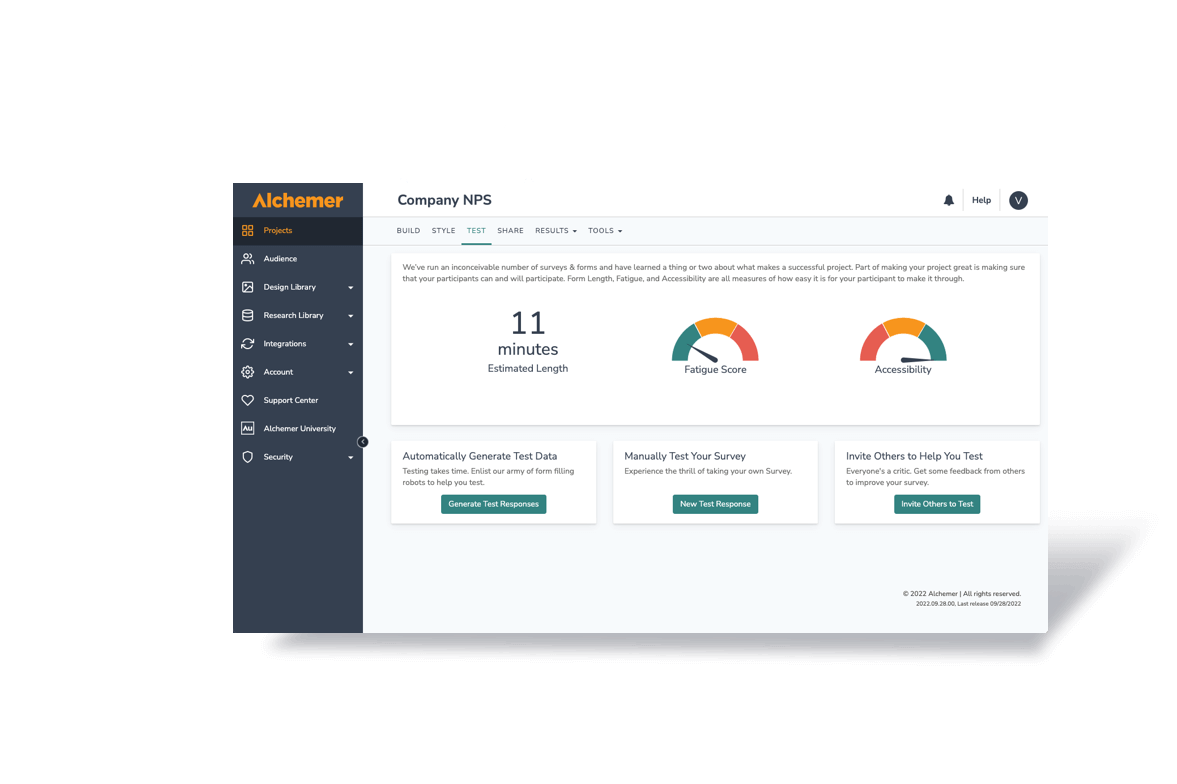Market research can often get de-prioritized. Yet, having an effective market research can be a game changer for your marketing strategy.
Take the time to craft a goal-oriented market research plan. This will ensure that your team focuses on high-value initiatives. These initiatives will either give you a leg up on the competition, strengthen your connection with your audience, or both.
But what does a effective, goal-oriented market research plan look like? We’ve compiled dozens (if not hundreds) here at Alchemer, and these are what we’ve found to be key drivers of success.
4 Common Market Research Areas
Most market research surveys are conducted to gain insight about the target audience and ways to expand market reach. Here are some common market research types:
Brand Awareness:
Brand awareness studies measure consumers’ awareness of your product or service.
These surveys are usually anonymous. They ask consumers how familiar they are with a brand. They also inquire about which familiar brands consumers recall for a particular product or service. These studies often include questions about buying behavior (usage, convenience, attributes, price, etc.).
Brand awareness studies will help you determine your brand’s relative position in the marketplace. They will also reveal where your competitors may have an edge.
Target Audience:
You can’t afford to target everyone. Knowing who your target audience is will help you craft relevant messages that resonate with them. By focusing on those who are most likely to purchase from you can prioritize your marketing spend and get the best possible ROI.
Customer Acquisition:
To acquire new customers, you need to understand what makes them tick. Surveying your ideal customers can help you learn how and why they chose your brand. This knowledge allows you to acquire more customers like them.
Customer Retention:
As marketers, we know that it is cheaper to retain current customers than acquire new ones. Conduct market research to measure customer satisfaction, increase customer loyalty, and drive up those retention numbers.
What Market Research Can Tell You
Knowing these common subjects of market research is a great place to start. However, you also need a strong understanding of what you hope to learn by the end of the process.
A well-designed market research survey can help you determine whether you need to:
- Enter a new market
- Launch a new product or service
- Promote brand awareness
- Optimize your marketing campaign
- Improve customer service
- Change messaging perception of your product or service
- Adjust price points
- Change your product packaging or delivery method
Once you’ve identified your objectives, it’s time to start creating the plan itself.
5 Success Tips for Market Research Surveys
These are our top five tips for giving your market research the best chance for success.
1. Define Your Marketing Challenge
The first step to designing a good market research plan is to define your need. What issue do you want to address? What do you hope to achieve? Set a survey goal to keep your market research focused on the decisions you are trying to make.
Conduct a qualitative study first to identify pressing issues or test a hypothesis before proceeding. Distribute this exploratory market survey to a focus group, or conduct a phone or personal interview.
Social media has become increasingly popular for gauging people’s interest. It is also a great way to engage your audience on a specific topic. You can post a short survey or a one question poll to quickly test your hypothesis before conducting a full study.
2. Craft Your Survey Questions Carefully
With your market research goal in mind, you are ready to design and build your survey questions.
Since you have already completed the exploratory phase, most of your questions should be quantitative. Quantifiable data will give you data you can act on. You can use a few qualitative questions but keep these to a minimum to avoid survey fatigue and abandonment.
Only ask questions that are relevant to your objectives. Asking the wrong questions will result in misleading answers that in turn will lead to poor business decisions.
Knowing how to ask a question is just as important as what to ask. Avoid leading questions and be aware of sensitive questions that some respondents may find too personal or offensive. Keep your questions simple, specific and direct.
3. Distribute Your Research Survey to the Right Audience
Before you start collecting data, consider the sample size needed for a statistically sound conclusion. Also, determine the distribution method to reach your target audience.
Market Sample Size
It is not realistic to think that you will be able to survey your entire target population, but you do need an adequate percentage and a representative cross-section of your consumer base.
Adjust the sample size for variations in your target population. You should also adjust it to find statistically significant differences between subgroups in the sample. You can read more about the intricacies of these types of analysis survey sample size here.
Survey Distribution Method
Choosing the right distribution method to collect your data is important. The distribution method determines which audience you can access. Additionally, different modes introduce different forms of bias.
Carefully consider your target audience and then find the best channel for reaching them.
For instance, if your target audience is an older demographic group, social media or internet channels might not be the best options. Consider alternative distribution methods that better reach this audience. Direct mail, phone, or personal interview may be the best option for reaching this audience.
If your audience is young and active, social media, email invitations, and mobile surveys might be effective options. A survey embedded on your website could also work well. Consider using other distribution methods to expand your survey’s reach. For example, include QR codes or web addresses on receipts, newsletters, and printed brochures.
4. Review Your New Market Research Data
Before you report and share your results, there are several steps you should take to review and prepare your data.
Clean your survey data:
Consider cleaning your survey data to locate any low-quality responses that could distort your conclusions.
Identify and weed out responses that have straight-line, Christmas tree, red herring, and/or outlier patterns.
Keep an eye on completion times as well. People who finish considerably faster than average may not be giving the questions their full attention.
Analyze your data:
Analyze the data to determine if your questions were answered in the format you expected. Unusual trends could indicate a problem with the question or question type.
If so, you may need to discount the question or run another study related to the learning objective.
Segment your data:
Filter your report by population segments. This will help you determine if the ratio accurately represents the demographics of your audience. If not, you may need to adjust the weight of your responses.
You can also segment your data by learning objective so that you can identify trends and patterns.
Report your results:
It’s time to highlight and share your findings! Consider data visualizations such as pie charts, bar graphs, and infographics that help to visually convey your message.
These visuals can drive home your data without requiring your audience to read each individual response.
5. Make Data-Driven Marketing Decisions
Armed with your market research data, you can confidently make sound marketing decisions. You can proceed with new campaigns confidently. You will have connected directly with your audience and can now create relevant messages.
Plan Your Next Online Market Research Survey
Budgeting and planning your market research can save you time, effort, and money in the long run. This approach ensures that you target the right audience, invest in the right sectors, and deliver the right branding message.
A well-designed marketing plan allows you to make tactical and strategic business decisions with confidence. So start planning your next market research survey!
Discussion:
How often to you conduct a market research study? Share how your organization has benefited from them!




